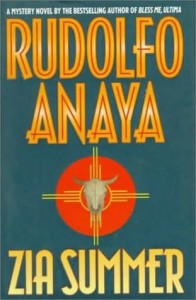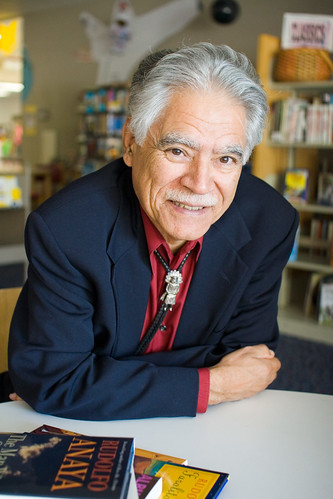Zia Summer by Rudolfo Anaya
(University of New Mexico Press, 1995)
 Rudolfo Anaya now has me hooked with his Sonny Baca detective stories. I am not sure why I began with the second book in the series, Rio Grande Fall, perhaps because of the setting of the Albuquerque Balloon Festival, but I liked it so well that I went back to read this first book. I also do not know why both novels have been waiting, unread on my bookshelf since I bought them both in 1997 at the Western Literature Conference in Albuquerque, the year after I had been national president and had hosted the annual conference in Lincoln, Nebraska. The Albuquerque conference was where I presented my past president’s address, and if I had known Anaya was in the audience, I would have been more nervous than I already was. After his reading that evening, Anaya signed my copy of Zia Summer: “Susanne– A great future! Rudolfo Anaya.”
Rudolfo Anaya now has me hooked with his Sonny Baca detective stories. I am not sure why I began with the second book in the series, Rio Grande Fall, perhaps because of the setting of the Albuquerque Balloon Festival, but I liked it so well that I went back to read this first book. I also do not know why both novels have been waiting, unread on my bookshelf since I bought them both in 1997 at the Western Literature Conference in Albuquerque, the year after I had been national president and had hosted the annual conference in Lincoln, Nebraska. The Albuquerque conference was where I presented my past president’s address, and if I had known Anaya was in the audience, I would have been more nervous than I already was. After his reading that evening, Anaya signed my copy of Zia Summer: “Susanne– A great future! Rudolfo Anaya.”
My husband read both of these detective stories shortly after our trip to the conference and loved them, but somehow they became buried lower and lower on my “to read” bookshelf. Perhaps I considered them too “popular culture” and feared that they would not live up to my admiration of his classic Bless Me, Ultima. Besides, as I state in my post on Rio Grande Fall, murder mysteries, even with a sexy P.I., have never been my favorite genre. Was I ever wrong!
The protagonist, Sonny Baca, is a fledgling private detective in Albuquerque who is hired by his aunt to investigate the murder of his cousin, Gloria Dominic. She is the wife of Frank Dominic, a wealthy man who aspires to becoming mayor of Albuquerque and building a canal system through the city on which he will build casinos. The antagonist is Anthony Pajaro. a.k.a. Raven, the evil leader of a sun-worshiping cult who believe in human sacrifice. Raven is also on a crusade against nuclear waste and is plotting to blow up a truck carrying highly toxic materials whose radioactive elements will poison Albuquerque. I am not exactly sure how Pajaro’s humanitarian environmentalism connects with his sun worship and human sacrifice except that he has no problem collecting devout followers or destroying everything in his path for his beliefs.
The plot is rather slow moving with Sonny constantly complaining that he is making no progress on the case although it picks up at the end. However, that does not matter because Anaya uses the time wisely to build Sonny’s character and the several inner conflicts he is facing, to develop a great sense of the setting and atmosphere of Albuquerque, and to enrich the story with cultural and historical backgrounds.
Sonny faces several inner turmoils, beginning with his attempt to follow in the legendary footsteps of his great grandfather and namesake, Elfego Baca, a local folk hero. Although he carries Elfego’s .45 caliber single action Colt revolver, with which his El Bisebuelo killed several men, Sonny has yet to fire his gun at anyone. In fact, he often rushes in too quickly, unthinking, and must be saved by others, including his girlfriend Rita. Rita poses another conflict. Sonny loves her, and although he turns down many tempting sexual offers, he is unable to make a commitment to marriage. Nor is he able to make strong connections with his family–his mother and twin brother Armando. He knows he should be a better son and brother, but he does not commit to strengthening his family, either. In addition, he is haunted by the spirit of his dead cousin whose soul will not be able to rest until Sonny undergoes a limpieza, a cleansing ceremony, with curandera Lozenza Villa. This ceremony takes place at the beginning of Rio Grande Fall.
Albuquerque, too, plays a strong role in the novel, for it is being environmentally challenged by Dominic, who wants to divert its water into Venetian canals rather than used for irrigation and by Raven, who wants to contaminate it with radioactive waste. In addition, Albuquerque is becoming a mecca for Californians and other who want to move to the historic city. Developers are building huge mansions in the valleys and destroying centuries old adobes and villas to build golf courses and subdivisions. Meanwhile, the homeless population is growing, and the poor are being marginalized and victimized with drugs.
 However, what I enjoyed most, and what will make this a very teachable book, are the customs, traditions, and symbols that inform the novel. As the title suggests, the Zia sun is the predominant symbol, and throughout the book references are made to sun worship in various cultures but especially New Mexico. The Zia symbol replays throughout the work in several manifestations as does the significance of the summer solstice. Tied in closely with that are the Lords and Ladies of the Light, the Senores y Senoras de la Luz who symbolize clarity and goodness. When they appear in the morning, Sonny’s “mind was clear, at rest, absorbing light, communing with something primal in the universe, connecting to the first moment of light in the darkness of the cosmos.” Don Eliseo, Sonny’s neighbor and mentor explains, “In the beginning was the chispa, the spark of imagination. . . . The chispa came to the womb of Madre Noche, the womb of time. The first light was born, male and female, and it was good” (183). On the other side of clarity is darkness where evil resides. This sets up the main theme as well as conflict of the novel: “The battle of good and evil is always for the soul” (60). Don Eliseo warns Sonny that “every generation repeats the struggle between good and evil” (62).
However, what I enjoyed most, and what will make this a very teachable book, are the customs, traditions, and symbols that inform the novel. As the title suggests, the Zia sun is the predominant symbol, and throughout the book references are made to sun worship in various cultures but especially New Mexico. The Zia symbol replays throughout the work in several manifestations as does the significance of the summer solstice. Tied in closely with that are the Lords and Ladies of the Light, the Senores y Senoras de la Luz who symbolize clarity and goodness. When they appear in the morning, Sonny’s “mind was clear, at rest, absorbing light, communing with something primal in the universe, connecting to the first moment of light in the darkness of the cosmos.” Don Eliseo, Sonny’s neighbor and mentor explains, “In the beginning was the chispa, the spark of imagination. . . . The chispa came to the womb of Madre Noche, the womb of time. The first light was born, male and female, and it was good” (183). On the other side of clarity is darkness where evil resides. This sets up the main theme as well as conflict of the novel: “The battle of good and evil is always for the soul” (60). Don Eliseo warns Sonny that “every generation repeats the struggle between good and evil” (62).
Among the many cultural references that Anaya expertly weaves into the plot are La Llorona, El Hombre Dorado, the bogey man Kookooee (El Coco), the Ojo de Dios, the Dance of the Matachines, and shapeshifting. The characters also exemplify the difference between healing brujas (curanderas) and evil brujos. And did I mention the delightful sparks of humor scattered throughout the narrative, especially the antics of a trio of Hispanic elders, who dub themselves Snap, Crackle, and Pop? I cannot think of a better book to engage reluctant readers while expanding their understanding of the culture of the Hispanic Southwest.